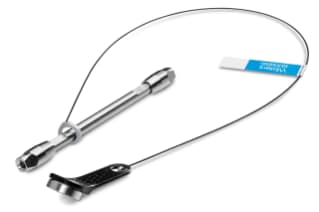
Suggested Use: Peptide Separations, Peptide Analysis, Peptide Mapping
|
Chemistry |
C18 |
|
Separation Mode |
Reversed Phase |
|
Particle Substrate |
Hybrid |
|
pH Range Min |
1 pH |
|
pH Range Max |
12 pH |
|
Temperature Limits |
80 C |
|
Maximum Pressure |
18000 psi (1240 Bar) |
|
Endcapped |
Yes |
|
Silanol Activity |
Low |
|
Particle Shape |
Spherical |
|
Particle Size |
1.7 µm |
|
Endfitting Type |
Parker-style |
|
Pore Size |
130 Å |
|
QC Tested |
Peptide |
|
Format |
Premier Column |
|
Surface Area |
185 |
|
System |
UPLC, UHPLC |
|
Particle Technology |
BEH |
|
Technique |
LC |
|
USP Classification |
L1 |
|
Inner Diameter |
2.1 mm |
|
Length |
100 mm |
|
Carbon Load |
18 % |
|
eCord |
Yes |
|
UNSPSC |
41115711 |
|
Application |
Peptide |
|
Brand |
ACQUITY |
|
Product Type |
Columns |
|
Units per Package |
1 pk |

ACQUITY Premier Peptide BEH C18 Column, 130Å, 1.7 µm, 2.1 x 100 mm, 1/pk
Invest in the ACQUITY Premier Peptide BEH C18 Column, the most versatile column option for high-performance separations and the ideal column for method development. The lab equipment uses MaxPeak High Performance Surface hardware, which considerably eliminates unwelcome analyte/surface interactions that might result in poor peak shape and signal intensity losses. The broadest usable pH range (pH 1–12) and trifunctionally bonded BEH particles are both features of the ACQUITY Premier BEH C18 Column, which has been specifically designed for peptide separations. With its C18 stationary phase and 1.7 µm particle size, it provides exceptional selectivity, resolution, and sensitivity for peptide characterization. Whether you are performing peptide mapping, proteomics, or peptide quantification, this column delivers reliable and consistent results.
Take advantage of the best aspects of liquid chromatography with greater sensitivity along with speed and resolution using the ACQUITY Premier BEH C18 Column. By fully utilizing the power of BEH Technology, which is a fundamental enabler of the speed, sensitivity, and resolution given by the analytical columns, the lab equipment demonstrates higher efficiency, strength, and pH range. This makes it simple for you to construct quicker, more reliable separations.
The 1.7 µm particle size of the ACQUITY Premier Peptide BEH C18 Column ensures exceptional efficiency and fast separations. It enables high-resolution peak shapes and improved chromatographic performance, resulting in accurate quantification and identification of peptides. The 130Å pore size allows for optimal sample penetration and interaction with the stationary phase, ensuring efficient separation and enhanced sensitivity. This makes the column suitable for applications such as peptide mapping, proteomics, and peptide quantification in pharmaceutical and biopharmaceutical research.
The ACQUITY Premier Peptide BEH C18 Column is known for its exceptional performance, reproducibility, and long column lifetime. It is designed to withstand high-pressure conditions and is compatible with a variety of mobile phases, including acidic and basic conditions commonly used in peptide analysis.
You may also want to explore the Cytochrome C Digestion Standard. The Cytochrome C Digestion Standard is a meticulously prepared product obtained through the digestion of Bovine Heart Cytochrome C (Uniprot # P62894) using sequencing grade trypsin. Each batch of this digestion standard undergoes rigorous quality control procedures, which are verified and documented in the accompanying certificate of analysis.
What Is The Recommended Flow Rate For The ACQUITY Premier Peptide BEH C18 Column?
The recommended flow rate for the ACQUITY Premier Peptide BEH C18 Column is typically between 0.2 and 0.4 mL/min. However, the optimal flow rate may vary depending on the specific application and instrument conditions.
What Types Of Detectors Are Compatible With The ACQUITY Premier Peptide BEH C18 Column?
The ACQUITY Premier Peptide BEH C18 Column is compatible with a wide range of detectors, including UV-Vis, fluorescence, and mass spectrometry detectors. It is particularly useful for LC-MS applications due to its high sensitivity and low level of sample carryover.